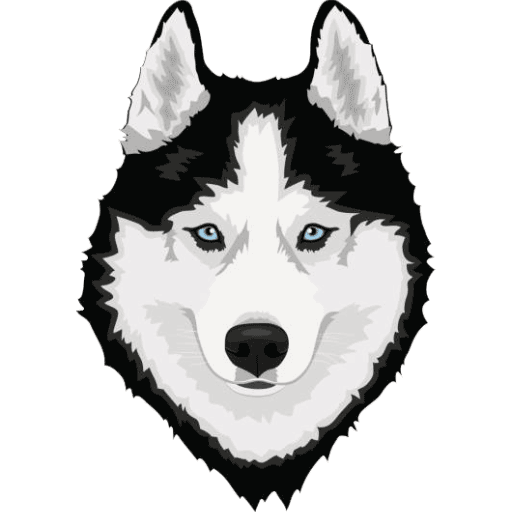Huskies have a stunning coat that can protect them from the coldest environments. If you’re thinking of getting a husky, you’ll need to know how huskies shed and how to deal with it.
Yes, Siberian huskies shed. Unlike other dog breeds that shed year-round, huskies shed once or twice a year due to seasonal changes. This is called “blowing” their undercoat and can take three to five weeks.
The right tools and information can make a big difference when dealing with your husky’s blowing phase. Let’s look at how huskies shed and how to deal with it.
How a Husky’s Double-Coat Works
Huskies have incredibly thick coats that allow them to survive in harsh environments. It’s common to see huskies curled up in the snow without a worry in the world.
Huskies can deal with the extreme cold thanks to their double coat. The inner coat is made of short and very thick fur. This coat keeps the husky warm as the thick layer is close to the skin.
The outer coat is made of longer hairs that repel water and help to shield against the wind, sun, heat, or cold.
This double-layered coat allows huskies to deal with freezing cold temperatures as low as -75 F (-59 Celcius).
Find out more on how Huskies deal with cold temperatures in this guide.
In summer, a husky’s topcoat helps keep him cool. While huskies prefer cold weather, their double coat does a surprisingly good job of regulating temperature.
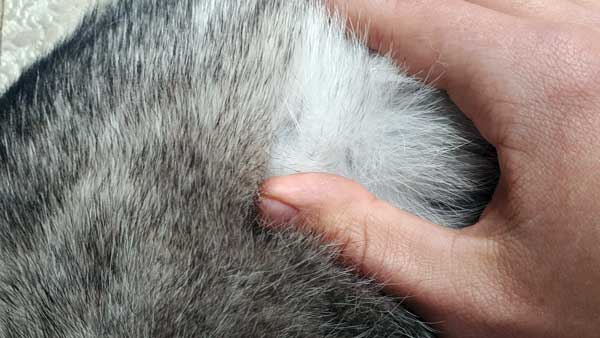
In the above photo, you can see the two coats on my husky. The long dark hairs make up the outer coat and have a slightly oily feeling to them.
Spread them out and you’ll see the white dense hairs making up the soft inner coat.
Important: Never Shave Your Husky
You’ve probably seen photos of shaved huskies without their coats. They look ridiculously with a fluffy head sticking out from a skinny body.
While it might sound like a good idea to shave your husky during warmer months, shaving a husky can cause serious health issues.
A husky’s coat is critical to it’s survival. The double coat regulates temperature and even in the warmer months, huskies need their coats for insulation.
Never shave a husky’s coat. It won’t help your husky cool down during hot weather.
In fact, shaving a husky can cause heat stroke as they won’t have their fur to regulate temperature.
The lack of fur means the sun will beat down directly onto your dog’s skin. A husky’s skin didn’t evolve to deal with direct sunlight, so even a mildly sunny day could be enough to kill a shaved husky.
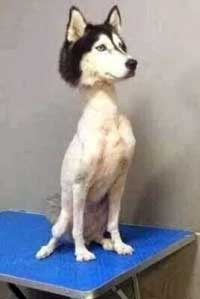
The only times when it’s appropriate to shave a husky is for surgeries or medical emergencies. Outside of medical emergencies, there are almost no good reasons to shave or clip a husky’s hair.
There are sadly many vets and dog groomers who are uninformed and do not realize the serious risks involved with shaving a husky.
If a “professional” dog groomer ever says it will be fine, run away!
Do Huskies Shed All Year Round
Unlike other dog breeds, huskies don’t shed all year round. Huskies have two seasonal coats: a heavy winter coat, and a lighter summer coat.
During winter, huskies will have an incredibly thick and fluffy coat. The heavy undercoat insulates the body and the long top coat shields against the win, rain, or snow.
As the season changes and temperatures rise, huskies don’t need such a thick coat. Dealing with a heavy coat in the middle of summer would be a disaster. So huskies “blow” their winter coat in a short period (usually around three weeks).
The shedding is mainly the thicker undercoat. A lot of hair will shed in a very short period of time.
Once this thick winter coat has been completely blown, you will notice a much lighter undercoat. There will still be a double-coat, but the undercoat won’t be as dense as before.
Some huskies only blow their coat once per year during spring. But many huskies also shed their summer coat during fall.
This shedding isn’t as severe as the shedding during spring, but it’s still a lot of hair in a short period of time. As your husky loses it’s summer coat, it will grow the thicker winter coat.

The above photo shows the start of my husky’s blowing during spring. I can effortlessly pull out clumps of hair with my hands. You can start to see the loose hair build up in clumps.
While this blowing phase can be a pain, it’s nice to know that for the rest of the year you’ll only have to deal with minimal hair around the house (compared to other dogs).
In the below photo, you can see what a husky looks like while blowing their coat. You can see the undercoat build up above his front legs.
All of that white hair sticking out is loose and you would be able to pull it out by hand. The ‘hole’ in the hind leg shows how much hair can be removed during this phase.
As you can see, a lot of hair comes out.
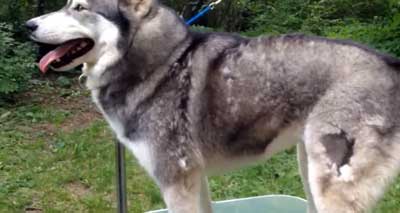
Keep in mind that huskies only experience this once or twice a year. So while the above photo might make it look like the husky is sick, it’s completely normal.
Is Husky Hair Hypoallergenic
Huskies don’t have a strong doggy smell like many other breeds. So it’s common for people to mistakenly assume that huskies are hypoallergenic.
As huskies don’t shed year round like other breeds, some people also take this as a sign that huskies are hypoallergenic.
Unfortunately, huskies are not hypoallergenic. It’s not the hair that causes allergies, it’s in the dander that flakes off from the skin. While huskies only shed once or twice per year, they still lose enough hair throughout the year to affect people with allergies.
Dog allergies are complicated and studies have found that there is no evidence of hypoallergenic breeds existing. Allergens are produced by a dog’s skin, saliva, and urine. That’s common across all dog breeds, so all breeds can cause allergic reactions.
There’s also a lot of variability from one dog to another. So even if you know somebody with dog allergies that claim they’re fine around huskies, it’s never that simple. Every dog produces different levels of allergens.
Do Huskies Shed A Lot?
First-time husky owners get quite a shock during the first spring blowing phase. The sheer amount of hair that a husky can shed is unbelievable.
It’s common for new husky owners to even see the massive shedding as a sign that the dog is sick. But it’s completely normal. Literally bucket loads of hair will come out every couple of days.
As a husky blows their undercoat, the dense hairs spread out. This makes it look like you’re removing an impossible amount of hair. Think of it like digging a hole in the ground.
You’ll find that you end up with a massive pile of dirt that doesn’t look like it could fit in the small hole. It’s the same with husky hair.
You’ll remove so much hair and your husky will look exactly the same as before.

It is insane how much hair a husky will shed in such a short amount of time. Daily brushing is crucial to keep it under control, or you’ll end up with hair everywhere and a very patchy husky.
During shedding, I would often walk over to my husky and gently pull out massive handfuls of hair at a time. To say that huskies shed a lot is a huge understatement as they blow their coat.
How To Deal With A Blowing Undercoat
When your husky starts to blow his coat, it’s time to get busy. The next few weeks can be a cleaning nightmare if you don’t manage it properly. Let’s look a some tips to get you through this phase and keep your husky happy.
Brush Your Husky Daily
As soon as you notice some shedding, make it part of your daily routine to brush your husky and remove as much hair as possible. Have your equipment handy (covered later) and dedicate a spot for brushing.
For my husky, we have her jump up on top of her kennel to be brushed. She loves getting brushed, so it quickly becomes a normal part of her day.
By brushing her daily, it makes the job much easier. If you leave it too long between sessions, the hair will build up and become harder to remove.
Two Brushes I Recommend
Most dog brushes are designed for light shedding and are terrible for huskies. Huskies have a very dense undercoat, which can instantly clog up fine brushes.
After buying a typical dog brush and spending most of my time removing hair from the brush, I realized there was a much better way.
The method I recommend makes use of two brushes:
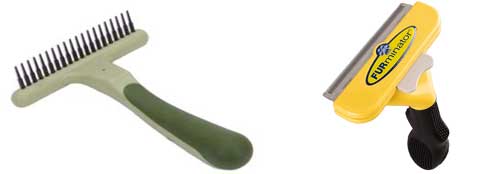
First, you start with a thick rake-like brush (link to Amazon for options) to remove most of the hair. The large gaps between the rake-like pegs makes it quick and easy to collect a lot of hair in the beginning without getting stuck.
It’s also easy to remove the hair from the rake after it becomes full. The less teeth, the better.
Then once that brush stops collecting hair (it should run smoothly through the hair without any resistance), use a finer brush such as the FURminator (link to Amazon for details) to remove the rest.
The finer brush will collect the hairs the rake wouldn’t be able to grab. It’s a perfect tool for collecting the last 20% of hair. With this method you’ll end up removing far more hair in less time, as well as making the next day’s brushing much easier.
I highly recommend using both of the above brushes as explained. While the FURminator is great for removing the last 20% of hair, it’s terrible for the first 80%.
The fine teeth will get stuck and tug at your husky. Use the rake for the first 80%, then the FURminator for the last 20%.
Roomba To The Rescue
If your husky is an inside dog, expect to see a lot of hair during this phase. While you will need to vacuum more regularly, an automatic vacuum like the Roomba can take a lot of work off your hands.
You will still need to brush your husky daily, but the Roomba will help keep your sanity during this hectic time.
An automatic vacuum is a great solution to the constant shedding your husky will go through as they blow their coat.
Teach Your Husky To Enjoy Brushing
When your husky starts to blow their coat, the last thing you want to have to deal with is an uncooperative husky. Once your husky understands that they’ll feel better after a good brushing session, they will be more cooperative.
Some husky owners give treats during the first few brushing sessions, while others let their husky play with a toy only during brushing.
The important thing is to train your husky to understand that they cannot leave until you decide the session is over. I learned this the hard way with my first husky as he would always run off after I finished one side (shown below).
The first few brushing sessions sets the standard for the future, so make sure you get it right. Be gentle and make the first few sessions as stress-free as possible.
Once your husky learns that brushing sessions are relaxing, it makes your job easier.
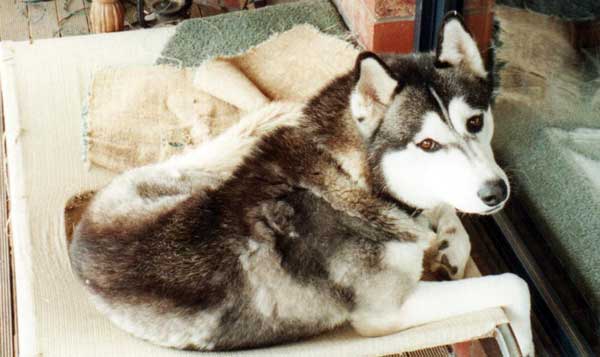
In the above photo of my first husky, Q, you can see how much lighter the coat is after removing loose hair. Q would always run off after I finished one side, so while he was in his blowing coat phase, he would always have a patchy coat as you can see in the photo.
With Sasha, we trained her to enjoy the brushing process, so she would stay until we were finished both sides.
Related Questions
When do huskies shed their puppy coat? Husky puppies start off life with a soft and short coat. Some time between 6-12 months, husky puppies will shed their puppy coat and get their adult double-coat. When this happens depends on the climate you live in and the current season.
Do huskies shed more than other dogs? Huskies are different from other shedding dogs such as German Shepherds or Labradors. While other dogs tend to shed year round, huskies only shed once or twice a year to change between their winter and summer coats. Apart from the blowing phase, huskies shed far less hair during the year than many other dog breeds.
Why is my Siberian husky shedding so much? If all of a sudden you start noticing clumps of hair fall out from your husky, don’t panic! It’s completely normal and a sign that your husky is blowing it’s coat. As explained above, this happens twice a year.

A heavily shedding Husky twice a year is one of the key behaviors Husky owners expect to see. Find out other key behaviors you can expect from a Husky in this list of 15 key Husky behaviors.
